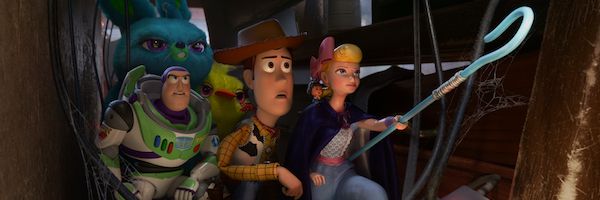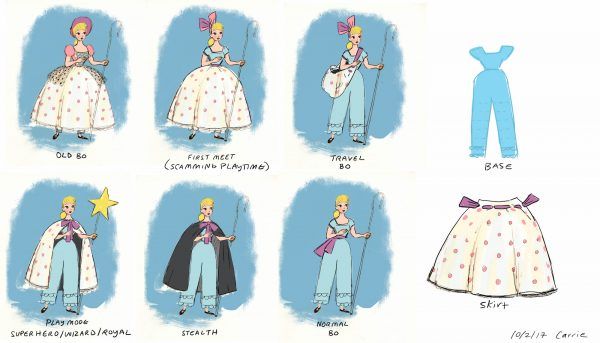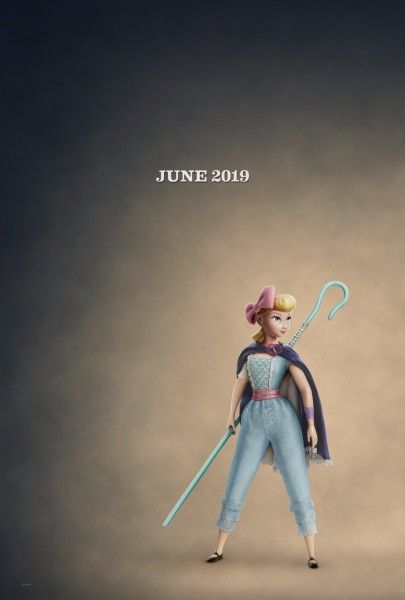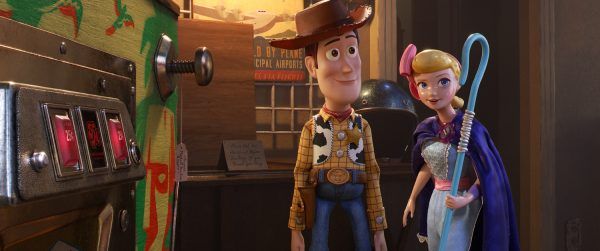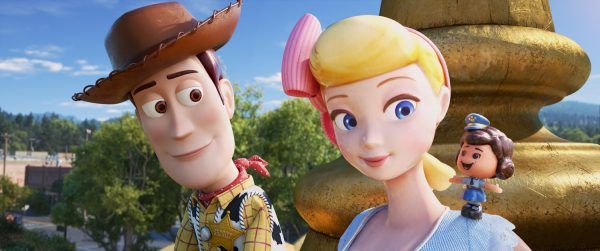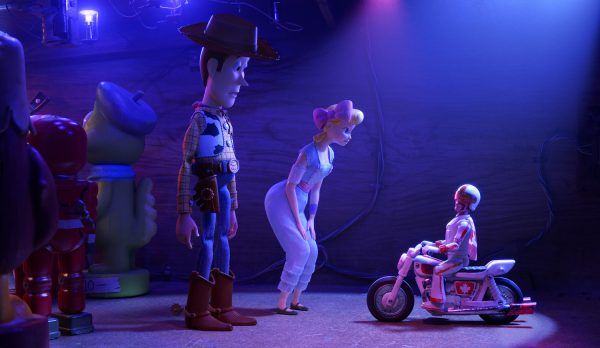When Collider visited Pixar Studios to learn as much as possible about Toy Story 4, there were two words we heard more than anything else, possibly even more than Woody and Buzz, and those words were "Bo Peep". The character voiced by Annie Potts hasn't been since 1999's Toy Story 2, but the new film brings her back in a big way, better and dare I say more badass than before. A ton of thought went into exactly how Bo should return; we saw entire walls of early concept ideas that ranged from a Bionic Bo to a Post-Apocalyptic Bo, alongside reference photos like Daisy Ridley's Rey from Star Wars and Uma Thurman's Bride in the Kill Bill films.
Guiding this process was the production's "Team Bo", a crew of artists, animators, and storytellers that eventually arrived on the idea of Bo as a "lost toy", roaming the real world without an owner to answer to.
"Team Bo was what we called the folks from story, and art, and animation, and cloth that really rallied around the idea of just keeping Bo as a really special and unique, stand-out character that didn't fall into tropes or anything specifically seen in an action film," producer Mark Nielsen told us. "It was important to us, very important to us, that Bo had a different worldview than Woody."
Added producer Jonas Rivera, "They would unflinchingly say, 'Bo wouldn't hold herself that way. That line is a little off.' Even Annie Potts would help steer it."
We sat down for a chat with two key members of Team Bo, Directing Animator Becki Tower and Story Artist Carrie Hobson, to discuss the character's new journey, the designs that didn't make it into the film, how her arc is separate from Woody's story, and more.
Collider: When you first came on to the project, what were those first days of figuring out Bo like?
CARRIE HOBSON: Yeah, the first days, I think Bo was such a blank slate still. We talked about all the possibilities of directions, but we also didn't want it to be so widespread that it didn't feel focused. A lot of it had to correlate to Woody and what he was going through. Woody's a character that thinks he always knows best. He thinks there's one set way and he's always the one in charge of the room. But how could we put Bo in this position that challenges that belief system? So we did a lot of brainstorming sessions and story to find her specific personality traits.
BECKI TOWER: In animation, we're here to support story. So we get in a lot of conversations of, "Okay, where do you think you're going?" Then we would just really try and riff with you and figure out how we could be helpful. "If you did that, it might look like this on-screen. We could try this. What about this physicality test that might help with that?" What are you trying to figure out that an animator could step in and logically help you break that down?
HOBSON: We were just talking about how much in boards there's so much thinking that goes into them. But oftentimes the drawings look really derpy, and very minimalist. Because we're so rushed. Thankfully, Becky and I had a constant communication early on and we'd constantly be like, "This scene, there's a lot of subtext." Always tracking Bo's emotional state throughout the movie. Making sure that's related to animation, then they'd pull off these amazing performances.
Can you remember the hardest thing to then bring to life visually, or make gel between the story side and visual side?
HOBSON: There's a lot of challenges, but definitely we talk a lot about the aggression of Bo, how to make her forceful and strong, but that can very easily read, especially in women characters, as annoying or unnecessarily mean. We wanted to make sure we nailed, at certain times, she's heightened in what she feels. Becki, you guys did such a great job pulling that off and making sure she's really controlled. Yeah, and when she gets triggered, making sure there's a specific reason and that we don't lose the emphasis of that. The power of that, by having it too far everywhere else. Being really specific with our choices, so that we're just being very thoughtful when she's upset, when she isn't happy. Being strategic to not lose the impact of certain moments.
We talked a little bit with the producers and directors about how we wanted Bo to have an arc that's separate from Woody. Can you talk a little bit about that?
HOBSON: So many times we would discuss how important that is. Because it's the nature of making a story that you, especially if there's a protagonist and it's not an ensemble cast, that every character should be supporting in a sense that main character's drive and arc, in a sense. But we wanted to make sure Bo's arc was her own specific drive. We thought, what a better way than Woody, he thinks one way. He's struggling in the movie with changing and adapting. That's her strength. It's the thing she wants, is to play on her own terms. She just wants to do things her way.
We also talked briefly about how the Bo team had input on stuff that was like, "Bo wouldn't do that" or "Bo wouldn't say it like that." Can you remember a specific moment where that was the case?
TOWER: Very simply, there's one shot where Bo and Woody are climbing up a pole, they're moving up this ride. The animator blocked in an idea where even Bo just is sort of hand-over-hand pulling herself up, and her legs are doing the same, they're echoing that, leg over leg over leg. Woody's doing something similar behind her, going hand over hand but his legs are wrapped around the pole, he's just dragging himself up. Even in a case like that, you can pull apart the contrast, where Bo is more reserved, she's porcelain, we want smooth movements. To lock down her legs and let her upper body just pull, and you lock down the bottom half, and you celebrate the ragdoll in Woody. So now, instead of him just pulling up his legs you can have him flop and flail and maybe he slips and his leg falls off, something like that. It's having the opportunity, shot by shot by shot, physically and emotionally pulling the two apart. She's stable and smooth and confident, very competent as she climbs this thing, and he's rag doll and awkward and bumbling. Just in visual appeal, it makes sense all the way down to the root level. Even in just how to climb up a pole, it was our opportunity to celebrate the difference between the two.
HOBSON: A moment I remember that, like, you asked what she would not do...what was super critical to me is when she meets Woody again, after all those years, we struggled with, "What's her reaction?" There's a lot of times when, I was boarding it myself, and I'd be like, "This doesn't work." What I did myself. It's not how Bo should be reacting, because you need to register a lot of feelings in a short amount of time. That's where that communication with animation really pays off. Because even though it's just one locked shot on Bo's face when she hears something about Woody, it's super critical that we get that right.
Something we've seen a lot today is just that attention to detail to what the material would look like, and in this movie, it just looks so real. I'm wondering what the line is, for you, where the animation starts to look too real?
TOWER: It's hard because we celebrate toy physicality and timing. Each toy, whether they have a crank mechanism or they're a plush toy or they're filled with air, we're always trying to celebrate those properties. Which, by rights, have their own timing built in. So we want to stay true to that. But also, there are ways we can sharpen this or sharpen that or tighten this and tighten that, either to juice out more humor or more appeal. It is this play on its a real world, it's a toy living in a basically real, realistic world, but then how can we use our animator brains to just make it more fun to watch? There were times where we were like "Okay, that would never happen. But eh, it's toys talking." [laughs] But again, it goes down to that believability vs. realism. We thread the needle quite often, but that's the fun in what we do. So long as it's believable and you're never pulled out with, "Wait, I don't know if I believe that."
Something I really loved seeing was all the alt-Bos, the sort of early versions of her when you were just throwing things at the wall and seeing what stuck. Is there one, in particular, that was hard to let go?
HOBSON: There's definitely a version of Bo where she was a little more of a Robin Hood type figure. Val mentioned she is in the store and she was a little bit more like a Peter Pan, with more of a gang. That was when she was more a part of the antique store still. What's great in sometimes letting go of things you're attached to is we got, as a result, the lost toy Bo. I remember it was really hard to me, I was like, "But...Bo in the store and there's gangs and it's mob city." But we had to contrast her to Woody.
Can you talk about the moment where you realized you had the Bo that was going to be the Bo in the movie?
HOBSON: I think it was a series of small adjustments to find her, for sure.
TOWER: In animation, ironically, it's usually toward the middle to the end that you really start to see the character sing. Our crew is learning how to animate them, how not to animate them, what is really appealing and working for a character and how to juice that. In "Bo Meet", it's a really powerful sequence where Woody and Bo have just met again for the first time. You see the dynamic between the two of them. Some of the animators in there were bringing such interesting choices and really appealing Bo animation that was like, "Oh man, are there now changes to backtrack and sprinkle a little more of that in here? We didn't think about treating this that way." Just simple eye animation, mouth appeal. Just posing. That stuff is learned along the way. You have a leadership team of animators who have the best intent on stuff but we don't know all the answers. A lot of that stuff has to play out in the game. You can practice all you want but once you're into the film and you're into shots and into reacting to real emotion and moments and sequences, that's when the whole team brings the magic and collectively learn. Every animator is so different. So it's like, "Wow, look what they did." Then we can merge those together as we move forward from sequence to sequence with any character.
HOBSON: Definitely there are critical sequences where, once we did in story, we nailed down, "This is what we want her drive to be, this is how we want her to contrast Woody." Two of the ones that leap out are, I boarded "Bo Meet", so that was super essential, and I boarded it probably over ten times. The other scene is "Recruit Duke", when Bo is pumping up [Keanu Reeves' character] Duke. The reason why that was always super important was that it has an essence of that old Bo, where she had a history with the store. We lost the version that was the Peter Pan, Robin Hood. But that one scene encompasses so many brainstorms where she was this character who lived in this antique store, has a history with these characters, and when she goes back, it's like going back to your old high school reunion. You're like, "I'm so far beyond you guys but I also care for you." And it shows her difference in how she'll react to a character like Woody and pumping up Duke.
Toy Story 4 hits theaters on June 21. Advance tickets are now on sale.

